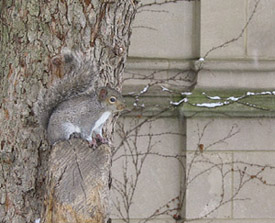 College
Report
College
Report
The secret social
lives of squirrels
They’re members of the U of C community
that are rarely mentioned and often upstaged by their flashy,
high-flying neighbor, the monk parakeet. Mostly seen as
part of the scenery, they are resourceful, amusing, and
when you’re holding a bagel, occasionally menacing.
They’re lowly squirrels. But a November symposium
elevated squirrels from campus clowns to research subjects.
As part of the Animal Behavior Brownbag Series—weekly
talks sponsored by the Laboratory of Comparative Development—Michael
Pereira, SM’80, PhD’84, a research associate
at the Lincoln Park Zoo, presented “The Secret Social
Lives of Eastern Gray Squirrels, Sciureus carolinensis.”
 Photo by Ryan
Nagdeman
Photo by Ryan
Nagdeman |
| The lone squirrel:
pariah or pioneer? |
“I’m sure you’re all
quite familiar with this animal because it’s all over
the campus and will mug you if you’re not careful
and take your lunches,” Pereira quipped to his audience
of 15 students and faculty members. “But if you get
15 to 35 Americans in a room and ask them to tell you a
detail about the behavior of gray squirrels, they can’t
do it.”
Pereira, who has also studied lemurs
and baboons, conducted research on the rarely studied squirrel
while teaching at Bucknell University. In a three-year study
he used squirrels chosen at random from around the Bucknell
campus and enclosed in a large, outdoor, wooden-and-wire
structure with nesting boxes. Applying primatology study
techniques, he observed whether metabolic changes affect
social behavior.
Kin relationships, Pereira’s study
revealed, seem to influence squirrel behavior. Related squirrels
are more willing to tolerate close proximity—two meters—than
unrelated ones, remaining close an average of 12–13
minutes at a time. Conversely, unrelated individuals are
more likely to antagonize one another. “Kin catch
hell from each other too, but a lot more of the aggression
gets directed toward nonkin.”
But then there’s poor little F5,
a female born in the enclosure. Throughout the study F5
nested alone, even during an experiment in which holes were
drilled in all but two nesting boxes, letting in the chilly
air. The other squirrels co-nested for warmth, but F5 was
excluded.
At this, psychology professor Martha
McClintock pricked her ears, wondering at F5’s purpose
within the group. Comparing squirrels to rats, her study
animal, she asked if outcast squirrels like F5 are “pariahs—ostracized
by their siblings? Or are they pioneer sentinels, bravely
sitting at the outposts sacrificing themselves because they
don’t mind being alone? What’s your sense of
what F5 is?”
“If she wasn’t restricted
in range she’d be long gone,” Pereira answered.
F5, he explained, was a “low ranker” whose “singleton”
nesting during the winter while the others co-nested was
because “she was hammered by her siblings. Even her
mother treated her poorly.”
“Then the question is,” McClintock
continued, “does every group need a scapegoat? If
someone were to take out F5…”
“…would someone else be the
scapegoat?” Pereira finished.
That sent the group on a discussion of
why a community needs a scapegoat: social coalition with
the group—having a common punching bag—or as
an easy way to show off. Unfortunately for F5, it seems
she might have filled both needs.
With a colleague from the University
of Illinois at Chicago, Pereira plans to continue his study
of squirrels. Working near his Oak Park home, he will map
where fox squirrels dominate and where gray squirrels dominate.
“If anyone wants to collaborate,” Pereira told
the audience hopefully, “I’m very interested.”
— Qiana Johnson


![]() Contact
Contact
![]() About
the Magazine
About
the Magazine ![]() Alumni
Gateway
Alumni
Gateway ![]() Alumni
Directory
Alumni
Directory ![]() UChicago
UChicago![]() ©2003 The University
of Chicago® Magazine
©2003 The University
of Chicago® Magazine ![]() 5801 South Ellis Ave., Chicago, IL 60637
5801 South Ellis Ave., Chicago, IL 60637![]() fax: 773/702-0495
fax: 773/702-0495 ![]() uchicago-magazine@uchicago.edu
uchicago-magazine@uchicago.edu
